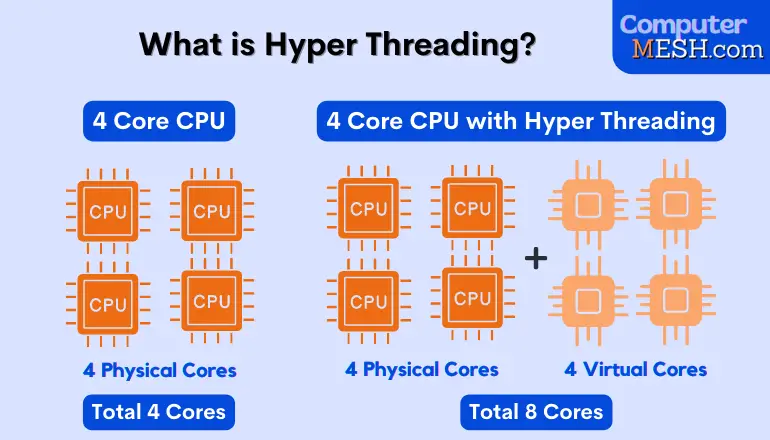What is Hyper threading? How does it Work? Any Drawbacks?
The number of cores has increased in processors over the past few years, but is hyperthreading among the most important additions yet?
Hyperthreading is a technology that has been gaining popularity in the past several years. Intel has been using it more and more in its high-end chips to provide better improvement in gaming.
So what is hyper threading, and should you get a CPU with hyperthreading, or does it have any drawbacks?
In this article, I’ll explain everything you need to know about hyperthreading and how it can benefit your computer performance.
Role of CPU and Cores
The CPU is like the brain of your computer. It processes the information provided by other computer parts and generates output data or performs actions accordingly. Whenever you start a program, the processor interprets the instructions and displays the result.
Then, you might have heard about “cores” in CPUs, and each core is like an additional CPU that can execute one process at a time. Older processors had only one core, but with the advancements, today’s processors have quad or even eight cores, which means they can perform multiple tasks at the same time.
So, it’s true, the more cores, the better, but what about hyper threading? Let’s know.
What is Hyper Threading in CPU?
Traditional processors have only one thread (single-threaded), so they can only perform one function at a time. Hyperthreading, on the other hand, is the Intel version of simultaneous multithreading (SMT).
SMT divides each CPU core into two virtual cores, allowing two sets of instructions to be processed simultaneously (as long as the program supports it). This means multithreading effectively doubles the number of cores available to the CPU.
Therefore, if you have a four-core processor with hyperthreading, you will have eight virtual cores. This is different from having double the number of physical cores.

Hyperthreading helps increase CPU productivity by allowing it to process twice the number of processes simultaneously; thus, the CPU can easily handle more demanding applications with ease.
How does hyperthreading work?
Hyperthreading uses virtual kernels, also known as logical cores, to share resources such as runtime and cache. This differs from having separate physical CPU cores. Hyperthreading is the increased efficiency of each core as resources are shared between logical cores. When one logical core is idle, another can use the resources to complete its tasks.
It is important to note that virtual kernels/cores do not have the same computing power as physical cores. Therefore, having more physical cores is always preferable to having more virtual ones, as each physical core has a unique architecture that makes it more efficient and powerful.
While hyperthreading can improve the performance of a quad-core processor, an eight-core processor will still outperform both a four-core with hyperthreading and a standard quad-core processor.
The effectiveness of hyperthreading depends on the software or program being used. If the software doesn’t create multiple streams or isn’t compatible with this hyperthreading technology, then the efficiency of the processing cores will be lower.
The Drawbacks of Hyper threading
Now you got what is hyper threading, following are the drawbacks comes with it:
Hyperthreading technology: Intel vs AMD
The Pentium 4, an Intel processor with the innovative NetBurst architecture, was released in November 2002. One of its many innovations was the hyper-threading technology. If I talk about AMD, they introduced their multithreading SMT technology along with their Ryzen line of processors in 2017. This technology operates similarly to hyper-threading and has the same features described above.
Is it Worth Getting CPU with Hyper Threading?
First, it is important to prioritize physical cores over logical/virtual cores. For instance, if you compare a processor with two cores and hyper-threading with another with four physical cores, select the second one!
Moreover, hyperthreading is not necessary for most applications. Hyper-threading only adds value if you run multiple programs with high requirements simultaneously; even then, these programs must be able to utilize it.
Following the use case where CPU with Hyperthreading technology suits best:
Video encoding: If you are a professional, use high-quality software for 3D rendering or video encoding to create more threads, often involving heavy CPU usage. The additional logical threads provided by Hyper-threading can help speed up the encoding process.
Multitasking: Hyper-threading allows the CPU to handle multiple tasks concurrently by splitting each core into two threads. This is useful when performing tasks that require the use of multiple programs simultaneously, such as video editing or running multiple browser tabs.
Server workloads: Hyper-threading can be particularly beneficial in server environments where multiple applications run simultaneously. It allows for better resource utilization and can help improve overall server performance.
Gaming: While not all games use Hyper-threading, some newer titles can benefit from it. Games that utilize multi-threaded rendering or physics engines can perform better on CPUs with Hyper-threading enabled.
However, for regular use like word processing or web browsing, Hyperthreading is unlikely to speed up the harddisk or CPU performance for these basic computing tasks.
Also, in some cases, enabling Hyperthreading can hurt gaming performance due to increased latency and lower clock speeds, so check compatibility to CPU bottleneck for your gaming program before going with Hyperthreading.
Summary
We hope this article what is hyper threading has explained everything you need to know about the hyperthreading of the CPU. But just in case, here is a summary:
- Hyperthreading divides each physical core of the CPU into two virtual cores.
- The physical core of the CPU is more powerful than the virtual one.
- Hyperthreading is important for high-performance software but not so important for simple programs.
Now you know what to pay attention when buying a CPU. Just, ask yourself the question – how many programs that you will use with hyper-threading or SMT? If the answer is unclear, it is better to pay attention to other processor characteristics, such as the number of cores, frequency, amount of L3 cache.
[Related]
